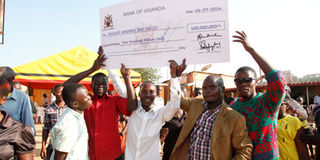Prime
Poverty level in Uganda down by 11 per cent - Report

No more poverty: Mulago washing bay youth receive a dummy cheque from President Yoweri Museveni last month at Katanga. PHOTO BY RACHEL MABALA.
What you need to know:
- In Northern Uganda, 64% of citizens were living blow poverty line in 2006 but currently 84% now live below poverty line on the National scale
- The teacher to pupil level is one teacher to 136 in northern Uganda, 90.5 in eastern Uganda, 47 in central region and 53 in western Uganda
- Only 35% of residents in Northern Uganda have mobile phones, 52% in eastern Uganda, 83%in central Uganda and 63% in Western Uganda.
The World Bank poverty assessment report for 2006-2013 shows that the proportion of the Ugandan population living beneath the national poverty line declined from 31.1 percent in 2006 to 19.7 percent in 2013.
Similarly, the country was one of the fastest in Sub-Saharan Africa to reduce the share of its population living on $1.90 PPP per day or less, from 53.2 percent in 2006 to 34.6 percent in 2013.
However, there has been increased poverty in Northern Uganda, despite increased international government public investments in the region.
The report reveals that regional inequality persists and appears to be on the rise.
"Progress was slower in the country's north and eastern regions which have least well-off, and marginalised population," the report reads.
In relation to Northern Uganda, 64% of citizens were living blow poverty line in 2006 but currently 84% now live below poverty line on the National scale.
The report further shows that in education, the teacher to pupil level is one teacher to 136 in northern Uganda, 90.5 in eastern Uganda, 47 in central region and 53 in western Uganda.

The teacher to pupil level is one teacher to 136 in northern Uganda, 90.5 in eastern Uganda, 47 in central region and 53 in western Uganda.
In social sector, only 35% of residents in Northern Uganda have mobile phones, 52% in eastern Uganda, 83%in central Uganda and 63% in Western Uganda.
The report continues: "poverty incidences are also higher in north at 43.7 per cent and the east is at 24.5 per cent compared to the central region which is 4.7 per cent and west at 8.7 per cent."
While launching the report the World Bank country director Christina Malmbrerg Calvo said that the report envisages inequitable development which must be addressed.
"Increasing investment in agriculture will help the country to achieve middle income status, there is also need to reduce income poverty gap through fiscal policy programmes."
In response, the minister for planning David Bahati said that government is aware of the imbalance but this was caused by insecurity in these areas for over two decades.




